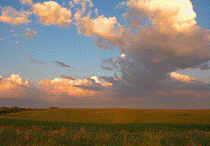North American Prairie Conference
Date of this Version
1989
Abstract
A Cecidomyiid midge (Contarinia wattsi Gagne') has been identified as a significant parasite of big bluestem [Andropogon gerardii Vitman var. gerardii] by adversely affecting the production of viable seeds. The midge was first identified from specimens collected from big bluestem racemes in 1983 in eastern Nebraska. Subsequent collections and studies have shown that it is widespread in the Great Plains, and that it can reduce seed yields of big bluestem by over 40%. The midges apparently over winter as diapausing larvae in disarticulated spikelets, emerge as adults at the time of early panicle emergence, and lay their eggs near developing caryopses. The larvae feed on the developing caryopses, pupate, and develop into adults within the florets. The adults emerge without leaving a trace. Up to three generations may occur per year with generation intervals of 13 to 16 days. The bluestem midge, in tum, is parasitized by a wasp that remains unidentified.


Comments
Published in Prairie Pioneers: Ecology, History and Culture: Proceedings of the Eleventh North American Prairie Conference, August 7-11, 1988, Lincoln, Nebraska (Lincoln, NE 1989).